Part 1:
Part 2:
In all of the animal kingdom the snails' shell is among the most astonishing wonders of evolution. The soft and flexible body of the living creature avoid of any skeleton construction, internal or external, is protected by the hard and lifeless shell. The shell, however, is not permanently connected to the body.
Among the molluscs the snails' shells also are a special thing. Even though their basic construction reveals their relation to other molluscs' shells, snails' shells nevertheless are clearly different from all other shells evolved among the other mollusc groups.
At first ground dwelling molluscs were protected against the unfriendly surrounding sea either by calcareous spicules (Solenogastres) or scales (Caudofoveata) or a number of shell plates (Polyplacophora). At a later point of evolution a shell in one piece came into existence, which could better protect its owner and made possible some astounding developments. Today we think to find such a type of shell in the vicinity of the Tryblidia class (with Neopilina, it was formerly known as Monoplacophora).
All higher molluscs, the so called Conchifera (shell-bearing molluscs), have such a shell in common. Among the Conchifera, next to the snails (Gastropoda), there also are bivalves (Bivalvia), scaphopods (Scaphopoda) and cephalopods (Cephalopoda).
The spirally coiled shell of a snail, though, is clearly different from that of other molluscs. There may be external similarities with a Nautilus shell. A limpet shell may also resemble externally to that of a Neopilina. But they are different nonetheless.
Like among the cephalopods, there is also among snails a tendency to reduce the large and cumbersome shell for the benefit of movability. Among terrestrial snails, as well as among their marine relatives, groups appear, with species bearing a shell in a different degree of reduction, up to completely shell-less snails or slugs.
![]() The Evolution of the Mollusc Shell.
The Evolution of the Mollusc Shell.
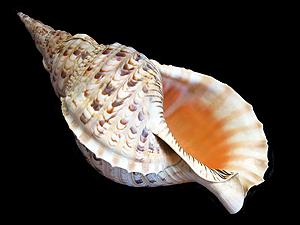 Triton's horn (Charonia tritonis). Source: Wikipedia. |
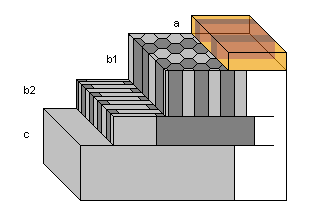 Schema: The layers of a mollusc shell. a: Periostracum; b: Ostracum: b1: Prism layer; b2: Plate layer; c: Hypostracum. No scale. Source: Ghesquiere (2000), revised [RN]. |
The basis of a snail shell is already laid during embryonic development. A small embryonic shell, the protoconch is already available to the hatching young snail. Until the shell becomes as impressive as for example the triton's horn (Charonia tritonis, see picture), there is a long way to go. A snail's shell grows in size as the shell wall increases in thickness, so that many sea snail shells become quite indestructible with old age, their owners well protected against any enemies from the surrounding sea.
An important part of the snail shells' success is how their wall is built in different layers each with a special purpose and each built by different cell layers.
At the snail's pallium (mantle) rim in the apertural (shell mouth) area of the shell there is a transversal cell layer which secretes calcareous matter, which will solidify into prism or plate crystals. The prisms stand tightly packed transversally to the shell wall (b1). The plates, in contrary, stand lengthwise and alternately, so a maximal firmness is achieved (b2). This prism layer or also main shell layer is called the ostracum.
In front of this cell layer, there is another, whose cells do not secrete calcareous matter, but an organic skin (the shell skin or periostracum), which is placed over the ostracum from outside. This organic skin consists mainly of conchin, a protein mix related to ceratin found in hair or tortoise shell and dentin found in teeth.
Whereas the main shell layer consisting of the hard mineral aragonite (chemically CaCO3) is mechanically very hard, on the other hand it is very susceptible to chemical corrosion. The shell skin, on the other hand, may be mechanically very weak, but it is quite unsusceptible to chemical corrosion and thus protects the shell layer below.
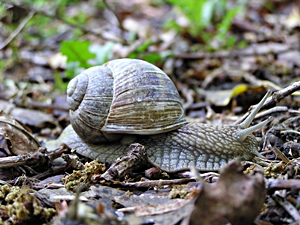 This Roman snail's shell skin (periostracum) has been seriously affected by pollution and acid rain. [RN] |
On the other hand, in many snails in urban areas, it is often seen, how pollution and acid rain also affect snails' shells. But without the protection of the periostracum, the snail's calcareous shell would probably be severely damaged.
In many snail species the periostracum may bear hairs (See Part 2), which among terrestrial snails minimize evaporation but improve contact to leaves in the often humid environment. Besides they are quite useful in shell camouflage (See Part 2). In contrary, shell spikes, as they appear in many marine gastropod species, are a construction of the ostracum layer.
In contrary to those two shell layers produced in the apertural area of the shell, there is another which is made all over the pallium (mantle) on the inside of the shell. This shell matter is responsible for thickening the shell wall. In snail shells it mainly consists of an amorphous calcium carbonate material.
Periostracum and ostracum cannot be rebuilt on the shell surface, except around the aperture. So areas which have to be repaired later (after damage due to an attack or an accident) are made from this amorphous matter and therefore are always recognizable.
In some snail groups, but mainly among the bivalves, the innermost layer of the shell can be made from tiny aragonite platelets. Those break the light in such a way that they reflect an iridescent shimmer. This nacre or mother-of-pearl is found among snails in the Turbinidae (turban shells), Trochidae (top shells) and Haliotidae (abalones or ormers) families. But main producers of mother-of-pearl, of course, are the numerous groups of pearl mussels (such as Margaritifera and Pinctada), whose populations consequently are more or less strongly threatened.
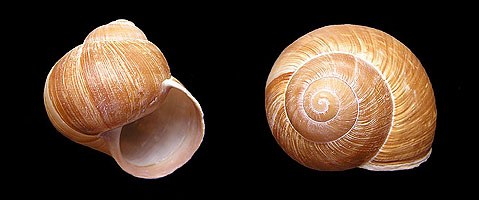 The shell of a Roman snail (Helix pomatia). Its asymmetric spiral shape is a consequence of a pro- cess called torsion. [RN] |
The snail shell may be built after the same general plan of all mollusc shells, is clearly different from others. A snail shell is coiled spirally, but the spire is clearly visible on one side of the body. Even in those snail species, whose shells do not reveal the spire on first sight, after some examination it will be found that there is a difference between the spire apex (tip) on one side of the shell and the hollow of the umbilicus (shell navel) on the other.
This special development of a snail's shell is based on an embryonic development referred to as torsion. During torsion the dorsal visceral sac and the pallium (the mantle responsible for shell construction) covering it, turn clockwise around their longitudinal axis. To save space, during torsion the visceral sac was coiled in a spiral and so was the shell produced by the pallium (mantle). That is why a snail shell, contrary to other mollusc shells, always is coiled to one specific direction.
![]() Torsion and the coiled snail shell.
Torsion and the coiled snail shell.
trita (dextral), Cochlodina laminata and Macrogastra ventri- cosa, both sinistral. Compare to text! Pictures: Helmut Nisters. |
As the snails' shells are coiled asymmetrically, right-handed (dextral) and left-handed (sinistral) shells can (and must) be distinguished.
When facing a snail shell in the apertural view, the aperture pointing to the bottom, in most species one can easily see that the shell whorls run to the right. On the other hand, there are also snail families, such as the door snails (Clausiliidae), among which most species are left-handed, with some exceptions. And there are also families like the Bulins (Enidae), among which there are right-handed and left-handed species in about equal numbers.
The coiling direction of snail shells, however, is mostly species specific, which means that a shell's coiling direction can be used as a means of identifying the species it belongs to.
There is, however, one exception: Occasionally, but generally very rarely, left-handed specimens occur in otherwise exclusively right-handed species. If they are Roman snails (Helix pomatia), such sinistral specimens are colloquially referred to as snail kings. But rare left-handed specimens of typically right-handed species occur all over the Gastropoda class. That is why in many shell collections there is a special place for "sinistral freaks".
Besides the coiling direction to the left or to the right, an exceptional variety of shell forms has evolved during gastropod evolution. There are round shells, like they are known from Roman snails and their relatives, but there are also highly coiled tower-like shells, such as that of a bulin (Ena montana) or a door snail (Balea biplicata).
On land the size development of a snail shell is limited by its weight. In the water there is buoyancy making a shell's weight almost insignificant. So in the marine environment, much larger gastropod shells, also much richer in forms, have evolved. Whereas the terrestrial snails reach about 10 inches in size at most, the largest gastropod living in the sea, Syrinx aruanus, is a nearly three feet long giant. Also very impressive are the large, heavy shells of helmet shells (Cassidae) and other large size groups.
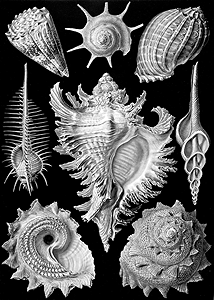 Shell forms of different marine gastropod groups. From: E. Haeckel: "Kunstformen der Natur". |
Like Ernst Haeckel already described in his book "Kunstformen der Natur", there are few limits to the rich variety of forms in marine gastropod shells, taking into account, that there is a much smaller number of marine gastropod species (about 7,000 out of 43,000) than terrestrial species (25,000 out of 43,000).
Since the Renaissance period, the colourful sea shells with their manifold forms have been collected in natural cabinets, which often later in time became the foundation of many modern natural history museum scientific collections.
And so today we know of cone shells (Conidae) with their geometrically conical shell, harp shells (Harpidae) with their transversal shell ribs resembling a harp's strings, and many more. Murex shells (Muricidae) with their often absurd looking shell spikes are doubtlessly well protected against shell-drilling predators (such as their own kind).
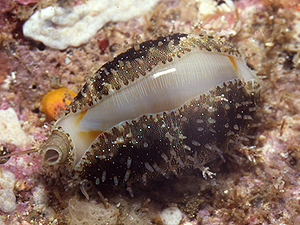 Cowry shell (Cypraea annulus). Source: Wikipedia. |
A special variety of admirably colourful shells may be found among the cowry shell family (Cypraeidae). Cowry shells have been used as a means of payment in the African and Arabian world until modern time, and until today they are popular pieces of jewellery or decoration.
The ear-shaped ormers or abalones (Haliotidae) may look like a mussel or clam from outside. The inside of their shells may even covered by a nacre layer. But anyway, they certainly are true snails. Especially on juvenile shells the whorls of their spire can well be seen. Besides, all abalones only have one shell, not two halves (See Part 2).
Specialists in outstanding performance also are the limpets (Patellidae), which dwell in one of the hardest environments in the sea – the tidal zone. Their shell does not only protect them from the destructive power of the tides, but it also serves as a water reservoir, should the limpet fall dry during low tide.
All so called prosobranch gastropods (systematically the group called Prosobranchia is polyphyletic) possess a shell lid. It is called an operculum, grown to the foot end, so it closes the shell aperture, should the snail withdraw into the shell. It is among most marine gastropods that an operculum will be found: The shell lids of the different snail groups are as variable as are their owners: For example the porcelain-like opercula of turban shells (Turbinidae) are used to make jewellery.
Very impressive in this regard also are the marine gastropods called conches (Strombus). Their opercula are formed like a scimitar or sickle. Besides closing their shell with it, Strombus species also use their operculum for locomotion, jumping over the sea floor. As they are also known to be able to hand out rather severe blows with their operculum, when disturbed, conches are also called "fencer shells".
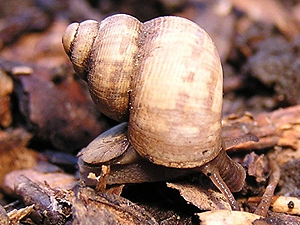 Round-mouthed snail (Pomatias elegans), with a visible shell lid (operculum). Picture: Michael Stemmer. |
There are also operculate snails on land. Among those the common round-mouthed snail or land winkle (Pomatias elegans) is able to close the mouth of its shell with an operculum, like its sea living relatives, such as periwinkles (Littorina).
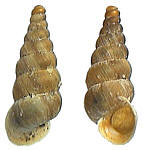 Cochlostoma henricae. Picture: Helmut Nisters. |
Other terrestrial operculate snails for example are the Aciculidae and the Cochlostomatidae.
The operculum must clearly be distinguished from different forms of lids that occur among other snail groups:
The hibernation lid or epiphragm of the Roman snail (Helix pomatia) is only a temporary construction, built during hibernation or the aestivation of lasting draught periods. After the snail has woken up, the epiphragm is thrown off and discarded, in contrary to the operculum, which is irreversibly grown to the foot.
Also the door plate (clausilium) of the door snails (Clausiliidae) has got nothing to do with the operculum. As a part of the shell it is not grown to the soft body. Therefore it is also found in empty shells, which the operculum usually is not.